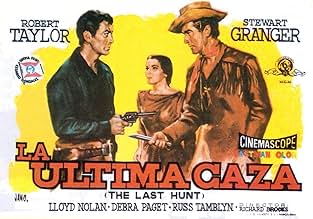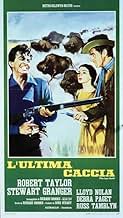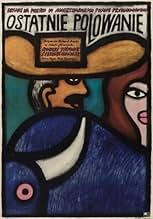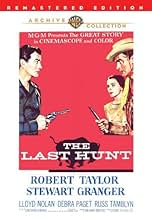PUNTUACIÓN EN IMDb
6,8/10
2 mil
TU PUNTUACIÓN
En Dakota del Sur de1883, dos cazadores de búfalos inician una disputa personal por una india capturada y un enfrentamiento con un grupo de asalto por unos caballos robados.En Dakota del Sur de1883, dos cazadores de búfalos inician una disputa personal por una india capturada y un enfrentamiento con un grupo de asalto por unos caballos robados.En Dakota del Sur de1883, dos cazadores de búfalos inician una disputa personal por una india capturada y un enfrentamiento con un grupo de asalto por unos caballos robados.
- Dirección
- Guión
- Reparto principal
Joe De Santis
- Ed Black
- (as Joe DeSantis)
Roy Barcroft
- Maj. Smith
- (sin acreditar)
Jimmie Booth
- Barfly
- (sin acreditar)
Steve Darrell
- Wells Fargo Man
- (sin acreditar)
Rosemary Johnston
- Woman
- (sin acreditar)
Casey MacGregor
- Bit Role
- (sin acreditar)
Jerry Martin
- Barber
- (sin acreditar)
Reseñas destacadas
7ccbc
I saw this movie (at a drive-in with my family) about the time, or not long after, it came out. I was eleven or twelve. I remembered scenes from this flick for fifty years until seeing it again on TCM. These scenes (a frozen buffalo hide, a guy sharpening a skinning knife, the white buffalo and its hide, and the final unforgettable scene) stayed with me for years. The movie still has power, though not as much as the mental rewrite I gave it over a half century ago threading together the scenes I recalled (nothing about the sex in my pre-adolescent memory). I found the editing and cinematography pretty poor when I looked at it a second time but the story was still good. I recall my father saying after the movie, "I thought Robert Taylor said he wasn't going to do that kind of role any more." I don't know what he meant. This is perhaps Taylor's best movie. He plays a very nasty villain. And maybe that's what my father was talking about. Anyway, a curious and interesting western, exploring themes that western writers had opened up long before but were new to Hollywood. It's too bad that the lead native roles were given to Russ Tamblyn and Debra Paget, but that was 50's Hollywood. Worth watching, but mentally re-edit this film and see if you can't come up with a classic must-see.
The Last Hunt is directed by Richard Brooks who also adapts the screenplay from the novel of the same name written by Milton Lott. It stars Robert Taylor, Stewart Granger, Debra Paget, Lloyd Nolan and Russ Tamblyn. Out of MGM it's a CinemaScope/Eastman Color production with music by Daniele Amfitheatrof and cinematography by Russell Harlan.
Buffalo hunter Sandy McKenzie (Granger) is tired of the hunt, but after a quirk of fate leaves him financially struggling, he accepts an invitation from Charles Gilson (Taylor) to go out on another profitable hunt. But when out on the range, Charlie starts to show a sadistic streak, and after his capture of an Indian girl (Paget), the two men are driven even further apart. Something will have to give.
It's quite often forgotten that one of the key weapons of war is food. The buffalo was an integral animal to the Native American way of life for a number of reasons, be it food, shelter, clothes or religious worth, it was an animal of great substance. So killing them off was a viable tactic for the white man during the Indian wars. The start of Richard Brooks' film tells us that in 1853 there were 60 million buffalo in the West, but within 30 years their number would be only 30 thousand...
What unfolds in this bleak but most potent of pictures, is a tale of men emotionally battered, albeit differently, by the war, a tale tinted (tainted) by racism and ecological concerns. Essentially it's Granger's tired of it all Sandy McKenzie against Taylor's blood lust racist Charles Gilson. In the middle is Paget's Indian girl, who is courted by McKenzie but owned unwillingly by Gilson, while on the outskirts observing are the skinners, half-breed Jimmy (Tamblyn) and Woodfoot (Nolan). McKenzie can barely pull the trigger to shoot the buffalo, his inner torment etched all over his face, but Gilson can fire rapidly, a maniacal glee surfaces with each buffalo death he administers. To Gilson, one less buffalo is one less Indian, his hatred of the Indian born out when he gets chance to kill those Indians that come to be in his way.
Is it the same kind of feeling you get around a woman?
The screenplay positively pings with intelligence and thought for its subjects, crucial given that it is essentially an intimate five character piece. Brooks is aware that the themes dwelling in his movie need to be handled with care, to take a sledgehammer to make a point would be wrong. With the exception of Paget (not her fault as she plays it as written) he garners great performances from his cast, with Taylor and Granger excellent and proving to be good foil for each other. Taylor has Gilson as outright scary and nasty, but there is a shade of sympathy asked of us viewers for he is a troubled mind. When a rumble of thunder pierces the sky above the group's camp, Gilson thinks it's a buffalo herd in flight, off he goes frantically in search of more kills, practically frothing at the mouth. This man clearly needs help, but out there on the frontier there is no help for battle scarred minds.
With actual footage of buffalo killings cut into the film (part of the government thinning of the herd programme), there's plenty to feel sombre about. However, there is great beauty to be found by way of Russell Harlan's photography out of Badlands National Park and Custer State Park. These lands were once home to much pain and misery, but forever beautiful they be and in Harlan's hands they offer up another reason why The Last Hunt is essential viewing for the Western fan. It's brilliant, one of the unsung classics of 50s Westerns and proof positive that Robert Taylor, when challenged to do so, could indeed act very well. 9/10
Buffalo hunter Sandy McKenzie (Granger) is tired of the hunt, but after a quirk of fate leaves him financially struggling, he accepts an invitation from Charles Gilson (Taylor) to go out on another profitable hunt. But when out on the range, Charlie starts to show a sadistic streak, and after his capture of an Indian girl (Paget), the two men are driven even further apart. Something will have to give.
It's quite often forgotten that one of the key weapons of war is food. The buffalo was an integral animal to the Native American way of life for a number of reasons, be it food, shelter, clothes or religious worth, it was an animal of great substance. So killing them off was a viable tactic for the white man during the Indian wars. The start of Richard Brooks' film tells us that in 1853 there were 60 million buffalo in the West, but within 30 years their number would be only 30 thousand...
What unfolds in this bleak but most potent of pictures, is a tale of men emotionally battered, albeit differently, by the war, a tale tinted (tainted) by racism and ecological concerns. Essentially it's Granger's tired of it all Sandy McKenzie against Taylor's blood lust racist Charles Gilson. In the middle is Paget's Indian girl, who is courted by McKenzie but owned unwillingly by Gilson, while on the outskirts observing are the skinners, half-breed Jimmy (Tamblyn) and Woodfoot (Nolan). McKenzie can barely pull the trigger to shoot the buffalo, his inner torment etched all over his face, but Gilson can fire rapidly, a maniacal glee surfaces with each buffalo death he administers. To Gilson, one less buffalo is one less Indian, his hatred of the Indian born out when he gets chance to kill those Indians that come to be in his way.
Is it the same kind of feeling you get around a woman?
The screenplay positively pings with intelligence and thought for its subjects, crucial given that it is essentially an intimate five character piece. Brooks is aware that the themes dwelling in his movie need to be handled with care, to take a sledgehammer to make a point would be wrong. With the exception of Paget (not her fault as she plays it as written) he garners great performances from his cast, with Taylor and Granger excellent and proving to be good foil for each other. Taylor has Gilson as outright scary and nasty, but there is a shade of sympathy asked of us viewers for he is a troubled mind. When a rumble of thunder pierces the sky above the group's camp, Gilson thinks it's a buffalo herd in flight, off he goes frantically in search of more kills, practically frothing at the mouth. This man clearly needs help, but out there on the frontier there is no help for battle scarred minds.
With actual footage of buffalo killings cut into the film (part of the government thinning of the herd programme), there's plenty to feel sombre about. However, there is great beauty to be found by way of Russell Harlan's photography out of Badlands National Park and Custer State Park. These lands were once home to much pain and misery, but forever beautiful they be and in Harlan's hands they offer up another reason why The Last Hunt is essential viewing for the Western fan. It's brilliant, one of the unsung classics of 50s Westerns and proof positive that Robert Taylor, when challenged to do so, could indeed act very well. 9/10
I saw this film about twenty years ago on the late show. I still vividly remember the film, especially the performance of Robert Taylor. I always thought Taylor was underrated as an actor as most critics saw him as solid, almost dull leading man type, and women simply loved to watch his films because of his looks. This film, however, proved what an interesting actor he could be. He did not get enough roles like this during his long career. This is his best performance. He is totally believable in a truly villainous role. From what I have read, he was a very hardworking and easy going guy in real life and never fought enough for these kind of roles. He basically would just do what MGM gave him. This film proves that he could have handled more diverse and difficult roles. The other thing I remember about this film is how annoying Lloyd Nolan's character was. Nolan was a great actor, but this character really aggravated me. The last scene of the film has stuck with me for all of these years. This film is definitely worth a look.
Pretty good Western set in the early 1880s , this is the story of one of the last buffalo hunts in the Northwest and Badlands National Park, Interior , South Dakota , by that time stayed survivors 3000 buffalo , only . Sandy McKinzie (Stewart Granger) is an ex-hunting buffalo and nowadays a tired rancher , he has a casual meeting with veteran hunter Charlie (Robert Taylor) , and both of whom join forces to hunt Buffalo . After that , Charley murders an Indian raiding party , and takes an Indian girl (Debra Paget , Anne Bancroft was injured on her horse , then was replaced by Paget) as his own ; then , both hunters fall out over the rescued young squaw . Meanwhile , lots of buffalo get killed one way and another . And Charlie kills a fair few Indians , too . When personalities crash , Charlie seeks vengeance on fellow buffalo hunter Sandy . As tension and subsequent confrontation develops between the two hunters till a surprising and icy ending .
Very good Western starring an excellent Robert Taylor as a revenger as well as seedy Buffalo hunter who gains his his identity killing both , Buffalo and Indians . Spectacular and breathtaking scenes when there happen the buffalo stampedes . It is an exciting Western/drama that holds you interest from start to finish and right through to the intriguing as well as frozen climax . The flick displays a deep denounce about senseless acts of murders as Buffalo as Indians . The buffalo scenes were real-life attempts at keeping the animals controlled . US government marksmen actually shot and killed buffalo during production as part of a scheduled herd-thinning . Interesting and thought-provoking screenplay based on the novel by Milton Lott . The plot is quite grim by Metro Goldwyn Mayer Western standards , though it results to be entertaining . In film premiere failed at box office and it was panned by critics and lukewarm reception by public ; however , nowadays reviewers carried a detailed reappraisal of the movie . The cast is frankly well . Robert Taylor is solid , if a bit stolid . Stewart is acceptable , as usual , and gorgeous Debra Paget as a young Naive squaw . The support cast is fine , as Russ Tamblyn as a young Indian who looks to be throughly enjoying himself and special mention for Lloyd Nolan as an old cripple called Woodfoot , an upright and honorable old man.
Colorful cinematography by Russell Harlan shot in National Parks such as Custer National Park, Badlands National Park, Interior, Sand Sylvan Park South Dakota, among others . Thrilling as well as evocative Original Music by Daniele Amfitheatrof . Directed and screen-played in magnificent style by Richard Brooks (Elmer Gantry, In cold blood, Lord Jim) who subsequently directed other good Westerns titled ¨Bite the bullet¨ with Gene Hackman and Candice Bergen and the ¨Professionals¨ with various tough stars as Burt Lancaster , Lee Marvin , Jack Palance and Robert Ryan . ¨The last hunt¨ is an authentic must see , not to be missed for buffs of the genre . A successful movie because of its awesome acting , dialog , score are world class.
Very good Western starring an excellent Robert Taylor as a revenger as well as seedy Buffalo hunter who gains his his identity killing both , Buffalo and Indians . Spectacular and breathtaking scenes when there happen the buffalo stampedes . It is an exciting Western/drama that holds you interest from start to finish and right through to the intriguing as well as frozen climax . The flick displays a deep denounce about senseless acts of murders as Buffalo as Indians . The buffalo scenes were real-life attempts at keeping the animals controlled . US government marksmen actually shot and killed buffalo during production as part of a scheduled herd-thinning . Interesting and thought-provoking screenplay based on the novel by Milton Lott . The plot is quite grim by Metro Goldwyn Mayer Western standards , though it results to be entertaining . In film premiere failed at box office and it was panned by critics and lukewarm reception by public ; however , nowadays reviewers carried a detailed reappraisal of the movie . The cast is frankly well . Robert Taylor is solid , if a bit stolid . Stewart is acceptable , as usual , and gorgeous Debra Paget as a young Naive squaw . The support cast is fine , as Russ Tamblyn as a young Indian who looks to be throughly enjoying himself and special mention for Lloyd Nolan as an old cripple called Woodfoot , an upright and honorable old man.
Colorful cinematography by Russell Harlan shot in National Parks such as Custer National Park, Badlands National Park, Interior, Sand Sylvan Park South Dakota, among others . Thrilling as well as evocative Original Music by Daniele Amfitheatrof . Directed and screen-played in magnificent style by Richard Brooks (Elmer Gantry, In cold blood, Lord Jim) who subsequently directed other good Westerns titled ¨Bite the bullet¨ with Gene Hackman and Candice Bergen and the ¨Professionals¨ with various tough stars as Burt Lancaster , Lee Marvin , Jack Palance and Robert Ryan . ¨The last hunt¨ is an authentic must see , not to be missed for buffs of the genre . A successful movie because of its awesome acting , dialog , score are world class.
10bux
Have no illusions, this IS a morality story. Granger is the troubled ex-buffalo hunter, tempted back to the plains one more time by kill-crazed Taylor. Granger can see the end is near, and feels deeply for the cost of the hunt-on the herds, the Indians and the land itself. Taylor, on the other hand admittedly equates killing buffalo, or Indians to 'being with a woman.' While Granger's role of the tortured hunter is superb, it's Taylor who steals the show, as the demented, immoral 'everyman' out for the fast buck and the goodtimes. There's not a lot of bang-bang here, but the story moves along quickly, and we are treated to a fine character performance by Nolan. The theme of this story is just as poignant today, as in the 1800s-man's relationship to the land and what's on it, and racism. Considering when this was made, the Censors must have been wringing their hankies during the scenes in the 'bawdy house', Taylor's relationship with the squaw, and much of the dialogue. Although downbeat, this is truly a great western picture.
¿Sabías que...?
- CuriosidadesUS government marksmen shot and killed buffalo during production as part of a scheduled herd-thinning. Close observation of the film reveals that the buffalo were shot in the head, which is why they would fall straight to the ground where they were standing.
- PifiasTodas las entradas contienen spoilers
- Citas
Indian Girl: You take away our food and now you kill our religion.
- ConexionesFeatured in MGM Parade: Episodio #1.20 (1956)
Selecciones populares
Inicia sesión para calificar y añadir a tu lista para recibir recomendaciones personalizadas
- How long is The Last Hunt?Con tecnología de Alexa
Detalles
Taquilla
- Presupuesto
- 2.121.000 US$ (estimación)
- Recaudación en todo el mundo
- 4236 US$
- Duración1 hora 48 minutos
- Relación de aspecto
- 2.35 : 1
Contribuir a esta página
Sugerir un cambio o añadir el contenido que falta

Principal laguna de datos
By what name was La última caza (1956) officially released in India in English?
Responde

































